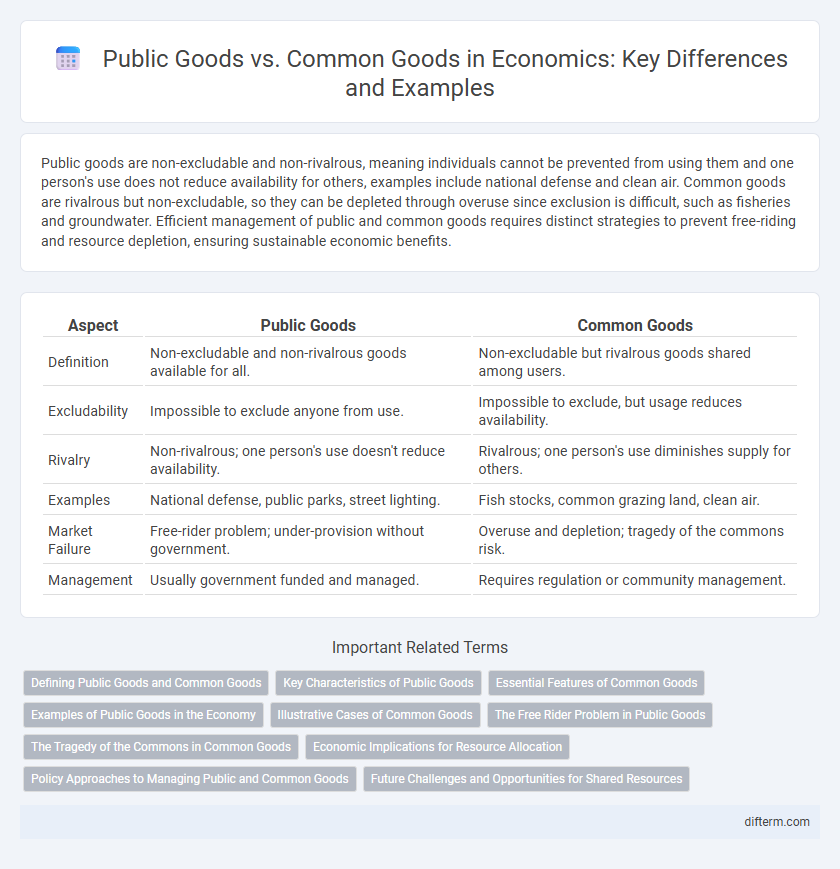Public goods are non-excludable and non-rivalrous, meaning individuals cannot be prevented from using them and one person's use does not reduce availability for others, examples include national defense and clean air. Common goods are rivalrous but non-excludable, so they can be depleted through overuse since exclusion is difficult, such as fisheries and groundwater. Efficient management of public and common goods requires distinct strategies to prevent free-riding and resource depletion, ensuring sustainable economic benefits.
Table of Comparison
| Aspect | Public Goods | Common Goods |
|---|---|---|
| Definition | Non-excludable and non-rivalrous goods available for all. | Non-excludable but rivalrous goods shared among users. |
| Excludability | Impossible to exclude anyone from use. | Impossible to exclude, but usage reduces availability. |
| Rivalry | Non-rivalrous; one person's use doesn't reduce availability. | Rivalrous; one person's use diminishes supply for others. |
| Examples | National defense, public parks, street lighting. | Fish stocks, common grazing land, clean air. |
| Market Failure | Free-rider problem; under-provision without government. | Overuse and depletion; tragedy of the commons risk. |
| Management | Usually government funded and managed. | Requires regulation or community management. |
Defining Public Goods and Common Goods
Public goods are characterized by their non-excludability and non-rivalrous consumption, meaning individuals cannot be excluded from use and one person's consumption does not reduce availability to others, examples include national defense and public parks. Common goods, also known as common-pool resources, are non-excludable but rivalrous, where consumption by one individual reduces the amount available for others, such as fisheries and groundwater resources. The distinction between public and common goods is critical for economic policy and resource management, influencing decisions on funding, regulation, and sustainable use.
Key Characteristics of Public Goods
Public goods are characterized by non-excludability and non-rivalrous consumption, meaning individuals cannot be excluded from their use and one person's consumption does not diminish availability for others. Examples include national defense, clean air, and public parks, which require government provision or funding due to free-rider problems. Unlike common goods, which are rivalrous and subject to depletion, public goods maintain availability regardless of consumption levels.
Essential Features of Common Goods
Common goods are characterized by their rivalrous consumption and non-excludability, meaning individuals can deplete resources but cannot be easily prevented from using them. Examples include fisheries, forests, and clean air, where overuse can lead to resource depletion or degradation. Effective management of common goods often requires collective action or regulation to prevent the "tragedy of the commons" and ensure sustainable use.
Examples of Public Goods in the Economy
Public goods in the economy include national defense, clean air, and public parks, all characterized by non-excludability and non-rivalry, ensuring accessibility to all individuals without depletion. These goods require government provision or funding due to the free-rider problem, where private markets typically underprovide them. Their role supports widespread social welfare, economic stability, and environmental sustainability.
Illustrative Cases of Common Goods
Common goods such as fisheries, public pastures, and groundwater basins illustrate challenges of overuse and depletion due to their rivalrous but non-excludable nature. The tragedy of the commons often emerges in these cases, where individual users have incentives to prioritize short-term gains over sustainable management. Effective governance mechanisms like quotas, community monitoring, and tradable permits have proven essential to balance utilization and preservation of these shared resources.
The Free Rider Problem in Public Goods
The Free Rider Problem occurs when individuals consume public goods, such as national defense or public parks, without contributing to their cost, leading to underfunding and potential inefficiency. Public goods are non-excludable and non-rivalrous, causing difficulty in excluding non-payers and incentivizing free riding. Common goods differ as they are rivalrous but non-excludable, which mainly raises issues of overuse rather than free riding.
The Tragedy of the Commons in Common Goods
Common goods, such as fisheries and public pastures, are rivalrous and non-excludable, leading to overuse and depletion when individuals act in self-interest, a phenomenon known as the Tragedy of the Commons. Unlike public goods like national defense or street lighting, which are non-rivalrous and non-excludable, common goods suffer from congestion and resource exhaustion due to lack of effective property rights or regulation. Economic policies addressing common goods often involve collective management or introduction of usage limits to prevent resource collapse and ensure sustainable consumption.
Economic Implications for Resource Allocation
Public goods, characterized by non-excludability and non-rivalry, often lead to market failures due to free-rider problems, resulting in under-provision without government intervention. Common goods, which are non-excludable but rivalrous, face the risk of overuse and depletion, known as the tragedy of the commons, necessitating regulatory frameworks or property rights to ensure sustainable allocation. Efficient resource allocation in both cases requires targeted policies to balance accessibility with preservation, optimizing social welfare and economic efficiency.
Policy Approaches to Managing Public and Common Goods
Effective policy approaches to managing public goods involve government provision and financing to address non-excludability and non-rivalry, ensuring accessibility without depletion. Common goods require regulatory frameworks and community-based management to prevent overuse and resource depletion due to rivalry and difficulty excluding users. Emphasizing sustainable usage and collective action helps balance economic efficiency and equity in resource allocation.
Future Challenges and Opportunities for Shared Resources
Public goods like national defense and clean air face challenges in funding and maintenance as populations grow, requiring innovative policy mechanisms to ensure sustainability. Common goods, such as fisheries and groundwater, risk depletion without effective regulation and community cooperation, demanding adaptive management strategies to balance use and conservation. Emerging technologies and data analytics offer opportunities to monitor usage and enforce equitable access, fostering resilience and long-term value in shared resources.
Public goods vs Common goods Infographic

 difterm.com
difterm.com